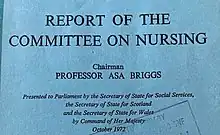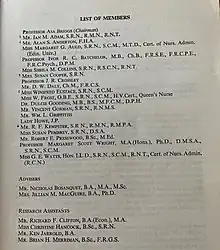Briggs Report
The Briggs Report (1972) was the report of the Committee on Nursing in the United Kingdom, which reviewed the role of nurses and midwives in hospitals and in community care. It made recommendations on education, training, and professional regulation.

Context
The Minister of Health set up a Committee on Senior Nursing Staff Structure in 1963, to bring standardisation of structure and pay for hospital nurses. The Committee, under Brian Salmon, issued a report in 1966 (now known as the Salmon Report), which recommended a hierarchy of nursing grades leading up to chief nursing officer.[1]
In March 1970, at a time of pay disputes and nurses' strikes, another larger committee was established by Richard Crossman, Secretary of State and head of the Department of Health and Social Security, with the remit:
To review the role of the nurse and midwife in the hospital and community and the education and training required for that role, so that the best use is made of available manpower to meet present needs and the needs of the integrated health service.[2]
This Committee on Nursing was expected to issue a report with wider-ranging recommendations for the future of nursing, midwifery and health visiting.
Committee on Nursing

The Committee on Nursing was headed by historian Asa Briggs. Other members of the committee included:
- Professor Margaret Scott-Wright, the first nursing professor in Europe,
- Royal College of Nursing members (and later Fellows) Sheila Collins, Susan Pembrey, and Margaret Auld.[1][3]
- Mental health nurses Ian Adams and R. F. Kempster.[4]
- Professor Sir Ivor R. C. Batchelor, medic, and Professor Rodney Crossley, economist.[5]
- Surgeon David W. Daly FRCS
- Ward sister Susan Cooper (who resigned in October 1970) and Winifred Eustace (who replaced Cooper in February 1971)[6]
- Area nursing officer Miss W Frost OBE
- Public health expert Dr Dulcie Gooding[7]
- Lady Howe
- Miss G. E. Watts, matron of the Leeds General Infirmary
Recommendations
In October 1972, the Committee on Nursing presented its report to Parliament.[8] The Committee made 75 main recommendations.[1]
Structural
The Briggs report suggested that a single statutory body, the Central Nursing and Midwifery Council, should oversee professional standards, education and discipline, rather than the three existing organisations, the General Nursing Council, the Central Midwives Board and the Council for the Training of Health Visitors.[2] The structural changes recommended by the report were so complex that they were not accepted until 1974.[9] They were not implemented until the United Kingdom Central Council for Nursing, Midwifery and Health Visiting (Electoral Scheme) Order of 1982.[10]
Education
The Committee recommended reducing the age of entry to nursing training[2] and offering an alternative form of training to the 2- or 3-year course in the form of 18 months training leading to certification, with the option to later pursue further training to obtain full registered nurse status.[1] Another suggested change in education suggested dedicated nursing colleges be created and that student nurses not be treated as part of the ordinary labour force of the NHS.[1]
Specialisms
The Report suggested that basic nurse education be followed by Branch specialisation, with trainee nurses choosing to select from adult, children, mental health and learning disability nursing specialisms.[3] It recommended that a new professional group was required to work with the "mentally handicapped".[11] In the mid-1970s, some areas began to introduce these specialist nurses.[12]
Impact
The report formed the basis of the Midwives and Health Visitors Act (1979).[9]
A Royal College of Nursing review written 50 years after the report called it a "breakthrough" that "set in train the first radical reform of nurse education since Nightingale."[3]
References
- Dewar, H A (June 1978). "The Hospital Nurse after Salmon and Briggs". Journal of the Royal Society of Medicine. 71 (6): 399–405. doi:10.1177/014107687807100603. ISSN 0141-0768. S2CID 26149498.
- Chapman, Christine (July 1973). "Report of the Committee on Nursing, Chairman: Professor Asa Briggs, Cmnd. 5115, HMSO, London, 1972. x+327 pp. £1.90". Journal of Social Policy. 2 (3): 286–288. doi:10.1017/S0047279400003123. ISSN 1469-7823. S2CID 72424679. Retrieved 17 January 2023.
- Tierney, Alison J. (2022-10-24). "50 years since the Briggs Report | Blogs | Royal College of Nursing". The Royal College of Nursing. Retrieved 2023-01-17.
- Arton, Michael (1998). The Professionalisation of Mental Nursing in Great Britain, 1850-1950 (PDF) (Thesis). UCL. p. 5.
- "Obituaries". University of Leeds. Retrieved 2023-03-14.
- Beach, Abigail; Davies, Celia (2013-02-01). Interpreting Professional Self-Regulation: A History of the United Kingdom Central Council for Nursing, Midwifery and Health Visiting. Routledge. pp. 5–19. ISBN 978-1-134-58187-0.
- "Obituaries: Dr Dulcie Gooding (née Rawle) - Lady Reid, 1933 - 2014" (PDF). The Royal Free Association Newsletter. 2015. p. 24. Retrieved 14 March 2023.
- Report of the Committee on Nursing / chairman, Asa Briggs; presented to Parliament by the Secretary of State for Social Services, the Secretary of State for Scotland and the Secretary of State for Wales ...October 1972. London: HMSO. 1972. ISBN 0101511507.
- "Report of the Briggs Committee on Nursing". Policy Navigator. Retrieved 17 January 2023.
- "United Kingdom Central Council for Nursing, Midwifery and Health Visiting (Electoral Scheme) Order 1982 (Hansard, 30 July 1982)". Hansard. Retrieved 2023-01-17.
- "Perspectives of the Briggs report : a discussion paper on the future role and training of subnormality nurses, and their relationship with residential care staff". The King's Fund Digital Archive. 1973. Retrieved 2023-01-17.
- "International Nurses' Day - looking into the past and then into the future". Camden and Islington NHS Foundation Trust. 10 May 2021. Retrieved 2023-01-17.
- Adams, John (2016-03-01). "One legacy of Lord Briggs is the value placed on nurse research". Nursing Standard. 30 (30): 31. doi:10.7748/ns.30.30.31.s40. ISSN 2047-9018. PMID 27008147.